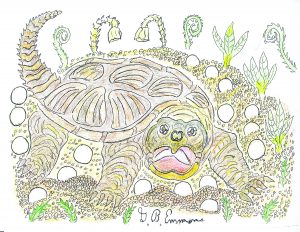The warming days of May are when the female snapping turtle crawls up out of the winter waters of hibernation and heads overland as much as a half mile or more to lay her eggs for the autumnal hatching of the next generation.
Along her traditional route of this annual pilgrimage, often to the same location, she may appear at the edge getting ready to cross a country road. Then, in less than a single day, she will lay thirty to forty eggs and bury them in the warm sands of a sunny slope as illustrated. When this reproductive duty is done, she promptly retraces her steps along the same route, returning to the muddy bottoms of aquatic habitat. This unfortunately leaves her eggs in a predictable location often to be found by hungry skunks, raccoons, and crows.
Terrestrial egg laying is a reptilian reproduction ritual for snapping turtles classified as the Chelydra Serpentina. The serpent symbol that often surfaces in the mind of mortal man is of course the scheming reptile alluding to temptation for reproduction in the biblical Garden of Eden. The so-called ‘snapper’ also seems to be evil when confronted on land by mankind. It has a similarly tricky combative disposition with powerful jaws and sharp edges of a tail not to be twisted. As an underworld aquatic demon, they have a reputation and are known to grab the feet of waterfowl ducklings and goslings and pull them under to be eaten.
When the young turtles hatch in August, they are only about half an inch long with faces only a mother could love. Immediately after hatching, they head off as a group, tracing their mother’s direction to the nearest water before predators can snatch them up. They were of course brought into life by a very selective parent. After breeding on land, she was able to store the sperm of her mate for a long waiting period until she sensed by instinct her reproductive system and environmental conditions were favorable.
Snapping turtles also have the most astounding temperature-dependent sex determination. Scientific tests prove that eggs incubated at about 68 degrees Fahrenheit produce only females, 70 to 72 degrees both males and females, and 73 to 78 degrees only males. They emerge from the leathery containers by using a small egg tooth to break the shells. Once they get bigger and their shells harden, their chances of living as long as ten years will greatly improve. But throughout their early lives, the odds are stacked against them and less than ten percent of eggs laid grow to maturity. Yet they are said to be primordial, a term meaning reproducing in their original form and re-enacted unchanged over millions of years.
We learned at an early age in science class that the first emergence of living forms on Earth crawled up out of a sea best described as a fertile source of a primordial soup. On a warm day in May, your casual route of travel may cross paths with a snapping turtle’s re-enactment of this ancient reproductive journey. May I suggest you do not judge your cause to disrupt or interfere in any way. Coming to light and unfolding across a country road for all to see is a moving link in the unbroken chain of survival renewed since the beginning of time on Earth.
By George B. Emmons
